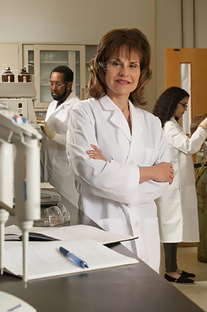In an occasional EM Update series, we feature interviews with former EM Assistant Secretaries to reflect on their achievements and challenges in the Cold War cleanup and to discuss endeavors in life after EM.

Dr. Inés Triay said serving as EM Assistant Secretary was challenging and extremely rewarding.
Before serving as EM’s Assistant Secretary in 2009 — leading the largest, most diverse and most technically complex environmental cleanup program in the world — Dr. Inés Triay was the cleanup program’s Principal Deputy Assistant Secretary, Chief Operations Officer, Deputy Chief Operations Officer and Carlsbad Field Office Manager. In that period, the program completed cleanup of the Department’s Rocky Flats site in Colorado and the Fernald site in Ohio. Triay also played an instrumental role in the commencement of transuranic waste disposal operations at the Department’s Waste Isolation Pilot Plant in New Mexico, including highly radioactive remote-handled transuranic waste. Before her career in EM, Triay served as a scientist and leader for 14 years at DOE’s Los Alamos National Laboratory, helping with environmental remediation and radioactive waste management advances.
What are you doing currently for your professional work?
I began my term as the Director of the Applied Research Center of Florida International University in October 2012. I love this work, and I love being in academia. Working with the students is truly rewarding.
Where do you live?
I live in Miami, Fla.
How do you view your term as the EM Assistant Secretary?
My tenure as the Environmental Management Assistant Secretary was challenging, yet extremely rewarding from an accomplishments perspective. With the funding from the American Recovery and Reinvestment Act we secured, we accelerated the reduction of the footprint of the Environmental Management’s contaminated areas.
What was your greatest achievement as the EM Assistant Secretary?
I think the work we did on the Recovery Act and the amount of progress we made was astounding. I was extremely proud of the ability of the EM complex to quickly, but effectively, use the additional funds provided to the EM program for progress on decontamination and decommissioning, removal and disposal of waste, environmental cleanup, treatment of groundwater and addressing contaminated soil.
What differences do you see in EM now and when you were the EM Assistant Secretary?
I believe the EM program, the capabilities of the program and the staff of the program continue to improve. The EM program has had continuous improvement since it began. It is a program that has had very clear and tangible accomplishments. I am very proud to have been part of the EM program and I still think it is an organization that continues to learn and improve.
Is there anything that you would change?
I believe that change in the EM program has occurred and needs to continue. When you are accountable to the taxpayers to complete the program, it is our responsibility to look for better ways to do the work within the EM program.
What misperceptions do people generally have about the program and about the EM Assistant Secretary?
The major misperception is underestimating the huge challenges of the program. Because of the nature of the work there were many unexpected conditions in the field and in waste management as well as the environmental restoration aspects of our program. The major misperception is that it is possible to very accurately predict completion of the entire program and the amount of money it will take to complete the program. I believe that it should be well understood that the EM Assistant Secretary position is extremely challenging. The cost of the program and trying to reduce the cost of the program, the needs of the community, the level of cleanup, interactions with regulatory agencies that oversee the work, as well as interactions with other stakeholders, need to be balanced in an effective way.
How has your experience as EM Assistant Secretary helped you in subsequent endeavors?
The experience that I had as the Assistant Secretary has helped me become a better manager as well as a better scientist. It has shaped the way that I interact with my coworkers as well as the way I pursue applied research in an academic environment.
Did you take any interesting trips while you were EM Assistant Secretary?
I found the trips that I took to the different facilities in the EM complex very interesting. I enjoyed looking at the work, talking to the workers, interacting with my coworkers and thinking about the strategic objectives of the program. I felt that every single one of those trips to the field was extremely interesting.
Do you have any personal accomplishments that you would like to talk about?
Once I left the DOE, I was able to lose weight. I lost 100 pounds! One of my hobbies is salsa dancing, and I am an advanced-level salsa student at academies for salsa in Miami, Fla.
—————————————————————-
Credit: EM Update | Vol. 5, Issue 9 | September 2013